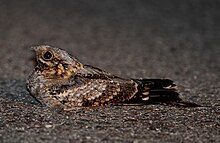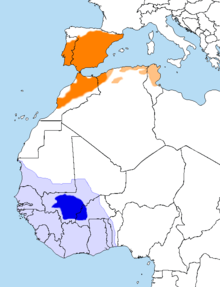Red-necked nightjar
| Red-necked nightjar | |
|---|---|
 |
|
| In Portugal | |
| Scientific classification | |
| Kingdom: | Animalia |
| Phylum: | Chordata |
| Class: | Aves |
| Order: | Caprimulgiformes |
| Family: | Caprimulgidae |
| Genus: | Caprimulgus |
| Species: | C. ruficollis |
| Binomial name | |
|
Caprimulgus ruficollis Temminck, 1820 |
|
 |
|
The red-necked nightjar (Caprimulgus ruficollis) is the largest of the nightjars occurring in Europe. It breeds in Iberia and north Africa, and winters in tropical west Africa.
Caprimulgus is derived from the Latin capra, "nanny goat", and mulgere, "to milk", referring to an old myth that nightjars suck milk from goats. The specific ruficollis is from Latin rufus, "red", and collum, "neck".
The common name "nightjar", first recorded in 1630, refers to the nocturnal habits of the bird, the second part of the name deriving from the distinctive churring song.
There are two subspecies: nominate ruficollis, breeding in Iberia, and desertorum breeding in North Africa. The North African form desertorum is paler than the Iberian one, and has different patterning on the base of its primary feathers: dark and orange bands of approximately equal width, compared to the narrower orange bands and greater extent of black of ruficollis.
The variegated plumage resembles the European nightjar. The adult is lichen-grey, barred and streaked with buff, chestnut and black. The underparts are barred. It is larger and longer-tailed than the more widespread species, and has a rufous neck-collar. Both sexes have white wing spots, tail sides and throat. During the day this nightjar lies silent upon the ground, concealed by its plumage; it is difficult to detect, looking like a bit of lichen-covered twig or a fragment of bark. The length is 32 cm, and the wingspan 64 cm. Like other nightjars, it has a wide gape, long wings, soft downy plumage and nocturnal habits.
Its call is a repetitive mechanical kyok-kyok-kyok..., which rises and falls as the bird turns its head from side to side. When it churrs, the bird lies or crouches along a branch or rail, but it will sing from a post. During courtship, and occasionally at other times, it uses a mechanical signal, a sharp cracking sound, caused by clapping the wings together over the back.
...
Wikipedia

